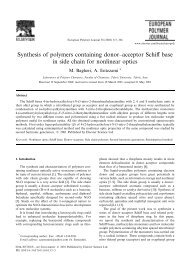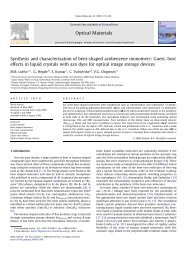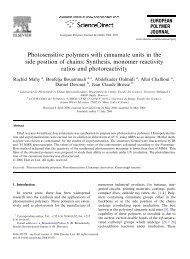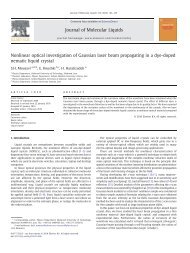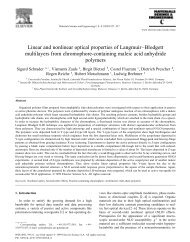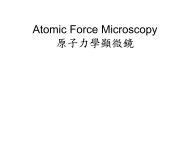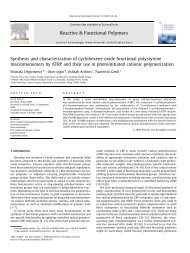Synthesis of pentafluorophenyl(meth)acrylate polymers: New ...
Synthesis of pentafluorophenyl(meth)acrylate polymers: New ...
Synthesis of pentafluorophenyl(meth)acrylate polymers: New ...
You also want an ePaper? Increase the reach of your titles
YUMPU automatically turns print PDFs into web optimized ePapers that Google loves.
Abstract<br />
<strong>Synthesis</strong> <strong>of</strong> <strong>pentafluorophenyl</strong>(<strong>meth</strong>)<strong>acrylate</strong> <strong>polymers</strong>:<br />
<strong>New</strong> precursor <strong>polymers</strong> for the synthesis <strong>of</strong><br />
multifunctional materials<br />
Marc Eberhardt, Ralf Mruk, Rudolf Zentel, Patrick Théato *<br />
Institute <strong>of</strong> Organic Chemistry, University <strong>of</strong> Mainz, Duesbergweg 10-14, D-55099 Mainz, Germany<br />
Received 10 October 2004; received in revised form 19 January 2005; accepted 26 January 2005<br />
Available online 25 February 2005<br />
Pentafluorophenyl <strong>acrylate</strong> and -<strong>meth</strong><strong>acrylate</strong> were polymerized using AIBN as a thermal initiator. The obtained<br />
<strong>polymers</strong> were soluble polymeric active esters that could be used for the preparation <strong>of</strong> multifunctional <strong>polymers</strong>.<br />
The reactivity <strong>of</strong> poly(<strong>pentafluorophenyl</strong><strong>acrylate</strong>) and poly(<strong>pentafluorophenyl</strong><strong>meth</strong><strong>acrylate</strong>) towards primary and secondary<br />
amines, as well as alcohols was investigated in a quantitative way. Both poly(active esters) reacted satisfactorily<br />
with aliphatic primary and secondary amines but only low conversion was found in the case <strong>of</strong> aromatic amines. Conversions<br />
<strong>of</strong> only 30% were reached when poly(<strong>pentafluorophenyl</strong><strong>acrylate</strong>) was treated with one equivalent <strong>of</strong> alcohol<br />
under base catalysis. In time resolved FT-IR studies the rate constants <strong>of</strong> the polymer analogous reactions were<br />
determined.<br />
Ó 2005 Elsevier Ltd. All rights reserved.<br />
Keywords: Active ester monomers; Multifunctional <strong>polymers</strong>; Reactivity; Polymer analogous reaction; Poly(acrylamide); Poly(<strong>pentafluorophenyl</strong><strong>acrylate</strong>)<br />
1. Introduction<br />
European Polymer Journal 41 (2005) 1569–1575<br />
The appearance <strong>of</strong> active esters and <strong>of</strong> coupling<br />
agents brought an unforeseen richness to the synthesis<br />
<strong>of</strong> peptides in organic chemistry [1]. Many different active<br />
esters have been presented: thiophenylesters were<br />
suggested by Wieland, activated <strong>meth</strong>yl esters by Schwyzer<br />
and nitrothiophenyl esters by Farrington et al. [2–4].<br />
<strong>New</strong> active esters, O-acyl derivatives <strong>of</strong> hydroxylamines<br />
*<br />
Corresponding author. Tel.: +49 6131 3926256; fax: +49<br />
6131 3924778.<br />
E-mail address: theato@uni-mainz.de (P. Théato).<br />
0014-3057/$ - see front matter Ó 2005 Elsevier Ltd. All rights reserved.<br />
doi:10.1016/j.eurpolymj.2005.01.025<br />
EUROPEAN<br />
POLYMER<br />
JOURNAL<br />
www.elsevier.com/locate/europolj<br />
such as N-hydroxysuccinimide esters and numerous<br />
aryl esters with electron withdrawing substituents in<br />
the aromatic ring, were investigated afterwards. Of<br />
these esters the pentachlorophenyl esters introduced by<br />
Kupryszewski excel a high reactivity, but suffer from<br />
the steric effect <strong>of</strong> the bulky activating groups [5]. Hence,<br />
these esters are less potent to be used in solid-phase peptide<br />
synthesis. A logical remedy for this shortcoming was<br />
the replacement <strong>of</strong> the five chlorine atoms by fluorine<br />
resulting in a very powerful active ester with less steric<br />
hindrance that retains its reactivity even in the matrix<br />
used for solid-phase peptide synthesis [6].<br />
Functional <strong>polymers</strong> are usually prepared by polymerization<br />
<strong>of</strong> the respective functional monomers.
1570 M. Eberhardt et al. / European Polymer Journal 41 (2005) 1569–1575<br />
However, the preparation <strong>of</strong> the corresponding monomers<br />
and/or their polymerization to high molecular<br />
weight <strong>polymers</strong> is <strong>of</strong>ten difficult or even impossible,<br />
especially when complex structures are desired. In many<br />
cases these problems can be evaded if pre<strong>polymers</strong> with<br />
reactive chemical functions in the side chain are utilized.<br />
As described above active esters are an ideal starting<br />
point in this kind <strong>of</strong> concept because these reactive<br />
groups can be transformed into amide groups by polymer<br />
analogous reaction with primary or secondary amines in<br />
a quantative and simple way, as outlined in Scheme 1.<br />
The fact that active ester <strong>polymers</strong> react fast and<br />
quantitatively with primary or secondary amines to<br />
form the corresponding poly(acrylamide) derivatives<br />
provides an opportunity to obtain macromolecules with<br />
specialized functionalities [7]. Furthermore, amines with<br />
a suitable structure are generally easier to synthesize<br />
than the corresponding monomeric derivatives.<br />
The motivation <strong>of</strong> this work was to provide alternative<br />
monomers for the synthetic scheme mentioned<br />
(Scheme 1), as part <strong>of</strong> the research <strong>of</strong> synthesizing<br />
multifunctional <strong>polymers</strong>. These materials can be used,<br />
for example, in pharmaceutical or biomedical applications<br />
[8,9].<br />
Acryloylchloride and <strong>meth</strong>acryloylchloride seemed<br />
not to be suitable monomers to be used as active esters<br />
as already shown by Schulz et al. [10,11]. They are<br />
aggressive chemicals, exhibiting a tremendous sensitivity<br />
towards nucleophiles and thus cannot be copolymerized<br />
with many other functional monomers. Additionally,<br />
they <strong>of</strong>ten yield cyclic or cross-linked products during<br />
the reaction with amines. As polymerizable active esters<br />
the acryl- and <strong>meth</strong>acryl esters <strong>of</strong> N-hydroxysuccinimide<br />
(NHS) are used almost exclusively [12–15]. They have<br />
been used successfully for the preparation <strong>of</strong> multifunctional<br />
poly(acrylamides) [16,17]. However, poly(NHS<br />
<strong>acrylate</strong>s) are poorly soluble which lead to the synthesis<br />
<strong>of</strong> novel active ester <strong>polymers</strong> that provide a better solubility.<br />
Ringsdorf and coworkers has designed further<br />
active ester monomers using trichlorophenol or N-hydroxy<br />
benzotriazol; all <strong>of</strong> them resulting in active ester<br />
<strong>polymers</strong> [18]. However, trichlorophenol suffers from<br />
the fact to be very toxic, while as active esters based<br />
on N-hydroxy benzotriazol are easily hydrolyzed, affecting<br />
the long time stability <strong>of</strong> these <strong>polymers</strong>. Therefore,<br />
n<br />
O<br />
R<br />
X<br />
Initiator<br />
active ester monomer poly (active ester)<br />
O<br />
R<br />
X<br />
n<br />
k<br />
R 2<br />
N<br />
H<br />
R 1<br />
O<br />
R 2<br />
N<br />
the survey for alternative active ester monomers and<br />
their resulting <strong>polymers</strong> is still challenging. Pentafluorophenyl<br />
esters proved to be very effective in peptide chemistry.<br />
Surprisingly, <strong>acrylate</strong>s <strong>of</strong> pentafluorophenol were<br />
not considered in polymer chemistry as active ester <strong>polymers</strong>.<br />
To the best <strong>of</strong> our knowledge, there is only one<br />
paper describing the synthesis <strong>of</strong> <strong>pentafluorophenyl</strong><strong>acrylate</strong><br />
and the efforts to polymerize it in bulk [19]. However,<br />
the obtained polymeric material was insoluble<br />
and consequently no size exclusion chromatography or<br />
any other detailed characterization could be presented.<br />
In this paper we describe the successful polymerization<br />
<strong>of</strong> <strong>pentafluorophenyl</strong><strong>acrylate</strong> and -<strong>meth</strong><strong>acrylate</strong> yielding<br />
soluble polymeric active esters. Furthermore model<br />
polymer analogous reactions converting them into<br />
poly(acrylamides) will be discussed.<br />
2. Experimental<br />
2.1. Materials<br />
All chemicals were commercially available and used<br />
as received unless otherwise stated. Benzene was distilled<br />
over CaH 2. THF was distilled over potassium. Azodiisobutyronitrile<br />
(AIBN) was recrystallized from diethylether.<br />
2.2. Monomer synthesis<br />
Pentafluorophenyl<strong>acrylate</strong> M1: Pentaflourophenol<br />
(5.4 g, 29.3 mmol) and 3.5 ml 2.6-lutidine (30.0 mmol)<br />
were dissolved in 50 ml dichloro<strong>meth</strong>ane. Under cooling<br />
acryloyl chloride (2.6 ml, 31.9 mmol) was added and the<br />
whole mixture stirred for 3 h at 0 °C. After removing the<br />
ice bath the reaction mixture was kept at room temperature<br />
overnight. After filtration <strong>of</strong> the solution to remove<br />
the precipitated 2.6-lutidine hydrochloride the<br />
filtrate was washed twice with 30 ml water and dried<br />
over MgSO4. The solvent was removed and the remaining<br />
liquid distilled under reduced pressure yielding a colorless<br />
product (4.9 g, 70%) with a boiling point <strong>of</strong> 27 °C<br />
at 0.05 mbar. A small amount <strong>of</strong> di-tert-butyl-p-cresol<br />
was added to avoid polymerization during the<br />
distillation.<br />
R R<br />
k m<br />
O<br />
R 1<br />
X<br />
m<br />
R 3<br />
N<br />
H<br />
R 4<br />
O<br />
R<br />
R 2<br />
N<br />
R 1<br />
O<br />
R 3<br />
R<br />
k m<br />
N<br />
statistical copolymer<br />
Scheme 1. Poly(active ester) as starting material for the preparation <strong>of</strong> multifunctional materials.<br />
R 4
1 H NMR (CDCl3): d/ppm: 6.70 (1H, dd, JHH = 17.1<br />
and 1.5 Hz), 6.36 (1H, dd, J HH = 10.3 and 16.6 Hz),<br />
6.16 (1H, dd, JHH = 10.2 and 1.5 Hz);<br />
19 F NMR (CDCl3): d/ppm: 162.77 (2F, dd,<br />
J FF = 12 and 18 Hz), 158.39 (1F, t, J FF = 15 Hz),<br />
153.02 (2F, d, JFF = 15 Hz);<br />
¼ 1:4318.<br />
n 25<br />
D<br />
Pentafluorophenyl<strong>meth</strong><strong>acrylate</strong> M2: M2 was synthesized<br />
as described for M1, starting from 3.0 ml <strong>meth</strong>acryloyl<br />
chloride (32.7 mmol) and the same quantities <strong>of</strong><br />
pentafluorophenol, 2,6-lutidine and dichloro<strong>meth</strong>ane<br />
gave 4.6 g <strong>of</strong> a colorless liquid (62%) with a boiling point<br />
<strong>of</strong> 30 °C at 0.03 mbar).<br />
1 H NMR (CDCl3): d/ppm: 6.43 (1H, t, JHH = 2 Hz),<br />
5.89 (1H, t, JHH = 1.5 Hz), 2.06 (3H, t, JHH =<br />
1.5 Hz);<br />
19 F NMR (CDCl3): d/ppm: 162.90 (2F, dd, JFF =<br />
12 and 18 Hz), 158.63 (1F, t, JFF = 15 Hz),<br />
153.17 (2F, d, JFF = 15 Hz);<br />
¼ 1:4397.<br />
n 25<br />
D<br />
The monomers M3 and M4 were prepared as described<br />
in the literature [21].<br />
2.3. Preparation <strong>of</strong> the <strong>polymers</strong><br />
In a typical polymerization a mixture <strong>of</strong> 5.0 g monomer,<br />
25 g dry benzene and 32.5 mg (0.27 mmol) azodiisobutyronitrile<br />
(AIBN) was placed into a Schlenk-flask<br />
and freeze-thawn three times. The flask was sealed, immersed<br />
in a preheated oil bath <strong>of</strong> 80 °C and kept there<br />
for 6 h. After removing most <strong>of</strong> the benzene the polymer<br />
was isolated by precipitation in <strong>meth</strong>anol. The crude<br />
polymer was dissolved in benzene, precipitated again<br />
in <strong>meth</strong>anol, centrifuged and finally dried in a vacuum<br />
oven at 40 °C. Usually between 4.0 and 4.25 g (80–<br />
85%) <strong>of</strong> a white powder is collected which is characterized<br />
by NMR and elemental analysis. The molecular<br />
weight distribution is obtained by gel permeation chromatography<br />
(GPC) in THF.<br />
Poly(<strong>pentafluorophenyl</strong><strong>acrylate</strong>) PM1:<br />
1<br />
H NMR (CDCl3): d/ppm: 3.07 (1H, br s), 2.09 (2H,<br />
br s);<br />
19<br />
F NMR (CDCl3): d/ppm: 162.59 (2F, br s),<br />
157.15 (1F, br s), 153.56 (2F, br s);<br />
IR: 1782.0 cm 1 (C@O).<br />
Elemental analysis:<br />
M. Eberhardt et al. / European Polymer Journal 41 (2005) 1569–1575 1571<br />
PM1: C: calc. 45.39%, found: 45.38%; H: calc. 1.26%,<br />
found: 1.32%;<br />
GPC data:<br />
M n = 24,050 g/mol;<br />
M w = 37,010 g/mol;<br />
PDI = 1.5.<br />
Poly(<strong>pentafluorophenyl</strong><strong>meth</strong><strong>acrylate</strong>) PM2:<br />
1<br />
H NMR (CDCl3): d/ppm: 2.41 (2H, br s), 1.38 (3H,<br />
br s);<br />
19<br />
F NMR (CDCl3): d/ppm: 161.33 (2F, br s),<br />
156.2 (1F, br s), 151.77 (2F, br s);<br />
IR: 1780.2 cm 1 (C@O).<br />
Elemental analysis:<br />
PM2: C: calc. 47.64%, found: 47.94%; H: calc. 2.00%,<br />
found: 2.19%;<br />
GPC data:<br />
M n = 26,680 g/mol;<br />
Mw = 48,830 g/mol;<br />
PDI = 1.6.<br />
The <strong>polymers</strong> PM3 and PM4 were prepared according<br />
to the literature [21].<br />
2.4. Polymer analogous reactions<br />
A general procedure was performed as follows: 0.15 g<br />
<strong>of</strong> poly(reactive ester) were dissolved in 15 ml dry DMF.<br />
One equivalent <strong>of</strong> amine or alcohol and base was added<br />
using syringes. The mixture was stirred over a period <strong>of</strong><br />
24 h at 50 °C under a nitrogen atmosphere. After evaporating<br />
the solution to dryness in vacuum the remaining<br />
crude product was redissolved in THF and precipitated<br />
in n-hexanes. In the case <strong>of</strong> secondary poly(acrylamides)<br />
the polymer was cleaned by dialysis in THF. The isolated<br />
product was finally dried in a vacuum oven at<br />
40 °C.<br />
2.5. Kinetic FT-IR measurements<br />
A general procedure to follow the polymer analogous<br />
reactions by FT-IR was performed as follows: the <strong>polymers</strong><br />
were dissolved in dry THF at a concentration <strong>of</strong><br />
0.02 mol/L. Then the respective nucleophile was added<br />
in one equivalent and the solution was placed in a<br />
50 °C tempered FT-IR transmission liquid cell. FT-IR<br />
spectra were then recorded in time intervals <strong>of</strong> 1 min<br />
for the primary amines and 10 min for the secondary<br />
amines, respectively. Time resolved conversion was calculated<br />
by the decrease <strong>of</strong> the area <strong>of</strong> the activated
1572 M. Eberhardt et al. / European Polymer Journal 41 (2005) 1569–1575<br />
carbonyl peak in the spectrum. The integral <strong>of</strong> the peak<br />
at 0 min was defined as 0% conversion.<br />
3. Results and discussion<br />
3.1. Monomers<br />
Pentafluorophenyl<strong>acrylate</strong> and -<strong>meth</strong><strong>acrylate</strong>, M1<br />
and M2, were prepared in a slightly modified way as described<br />
in the literature [20]. Briefly, pentafluorophenol<br />
was allowed to react with acryloyl chloride in the presence<br />
<strong>of</strong> an auxiliary base, as shown in Scheme 2. Purification<br />
by vacuum distillation yielded the monomers M1<br />
and M2. They were soluble in many solvents such as<br />
dioxane, diethylether, chlor<strong>of</strong>orm, benzene, <strong>meth</strong>anol,<br />
n-hexane. Further they were stable, not air sensitive<br />
and relatively robust against hydrolysis in air. Preparation<br />
in a large scale was possible and even after storage<br />
at 10 °C under nitrogen over several weeks no signs <strong>of</strong><br />
decomposition could be detected.<br />
The 19 F NMR spectra <strong>of</strong> M1 and M2 showed the expected<br />
signals <strong>of</strong> the five fluorine atoms attached to the<br />
aromatic ring. Fig. 1a exemplarily shows the 19 F NMR<br />
spectrum <strong>of</strong> M1. Integration <strong>of</strong> the peaks gave a 2:1:2<br />
ratio, as expected. The fluorine peaks <strong>of</strong> the monomer M1<br />
are found at 162.8 ppm, 158.4 ppm, and 153.0 ppm,<br />
respectively. Pentafluorophenol itself showed signals at<br />
163.9 ppm, 164.2 ppm and 168.7, which are not<br />
present in the 19 F-spectrum <strong>of</strong> M1 thus supporting the<br />
purity <strong>of</strong> the monomer. An analogous 19 F NMR spectrum<br />
was measured for M2.<br />
3.2. Polymerization<br />
According to Blazejewski and coworkers M1 seemed<br />
to cross-link during polymerization in bulk [19], asa<br />
consequence we investigated the solution polymerization<br />
<strong>of</strong> M1 and M2, respectively. The polymerization could<br />
Cl<br />
R<br />
O<br />
+<br />
F<br />
F<br />
OH<br />
F<br />
F<br />
F<br />
+ 2,6-Lutidin<br />
_<br />
2,6-LutidinHCl<br />
F<br />
F<br />
Fig. 1. (a) 19 F NMR spectrum <strong>of</strong> monomer M1 and (b) 19 F<br />
NMR spectrum <strong>of</strong> PM1.<br />
be accomplished at 80 °C using benzene or dioxane as<br />
solvents and azodiisobutyronitrile (AIBN) as a thermal<br />
initiator. After the typical polymerization time <strong>of</strong> 6 h<br />
the <strong>polymers</strong> remained in solution and did not precipitate<br />
in contrast to the polymerization <strong>of</strong> NHS-<strong>acrylate</strong>s<br />
or NHS-<strong>meth</strong><strong>acrylate</strong>s [21]. The <strong>polymers</strong> were then isolated<br />
by precipitation into <strong>meth</strong>anol. After reprecipitation<br />
from benzene into <strong>meth</strong>anol the isolated <strong>polymers</strong><br />
PM1 and PM2 were characterized by NMR and elemental<br />
analysis. Fig. 1b depicts exemplary the 19 F NMR<br />
spectrum <strong>of</strong> PM1. The 19 F NMR spectrum <strong>of</strong> poly(<strong>pentafluorophenyl</strong><strong>acrylate</strong>)<br />
PM1 showed three broad peaks<br />
O<br />
F<br />
R<br />
O<br />
F<br />
F<br />
AIBN<br />
benzene, heat<br />
M1: R=H PM1: R=H<br />
M2: R=CH 3<br />
F<br />
F<br />
O<br />
F<br />
R<br />
O<br />
F<br />
F<br />
PM2: R=CH 3<br />
Scheme 2. Preparation <strong>of</strong> M1, M2 and their thermal polymerization to PM1 and PM2 using AIBN in benzene.<br />
n
at 162.6 ppm, 157.2 ppm, and 153.6 ppm with a<br />
2:1:2 integral ratio. No monomeric peaks could be detected,<br />
as the polymeric peaks were slightly shifted from<br />
those <strong>of</strong> the monomers. A similar 19 F NMR spectrum<br />
was measured for poly(<strong>pentafluorophenyl</strong><strong>meth</strong><strong>acrylate</strong>)<br />
PM2.<br />
Mw values are measured by a light scattering detector<br />
and are therefore absolute values. The polydispersity<br />
index (PDI = M w/M n) showed a smaller distribution<br />
than the expected distribution (PDI = 2) for a free radical<br />
polymerization. However, one has to keep in mind<br />
that the polymeric material was isolated by precipitation<br />
and therefore the measured PDI is not exactly the one<br />
for the solution polymerization. Additionally, Mw values<br />
were determined by light scattering, a <strong>meth</strong>od, which<br />
tends to underestimates low molecular weights.<br />
The obtained <strong>polymers</strong>, PM1 and PM2 were highly<br />
soluble in organic solvents such as toluene, chlor<strong>of</strong>orm,<br />
tetrahydr<strong>of</strong>urane, di<strong>meth</strong>ylformamide, acetone,<br />
di<strong>meth</strong>ylsulfoxide or dioxane but completely insoluble<br />
in n-hexane or <strong>meth</strong>anol. Compared to poly(N-acryloxysuccinimide)<br />
and poly(N-<strong>meth</strong>acryloxysuccinimide) which<br />
are only soluble in di<strong>meth</strong>ylformamide and di<strong>meth</strong>ylsulfoxide,<br />
PM1 and PM2 are already superior for any following<br />
polymer analogous reaction from a solvent<br />
point <strong>of</strong> view.<br />
3.3. Polymer analogous reactions<br />
M. Eberhardt et al. / European Polymer Journal 41 (2005) 1569–1575 1573<br />
3.3.1. NMR studies<br />
In order to be able to compare the novel active ester<br />
<strong>polymers</strong> PM1 and PM2 with established <strong>polymers</strong><br />
poly(N-acryloxysuccinimide) PM3 and poly(N-<strong>meth</strong>acryloxysuccinimide)<br />
PM4 were prepared according to the<br />
literature [21]. However, they suffer, as mentioned earlier,<br />
from their poor solubility. Therefore, for a quantitative<br />
comparison <strong>of</strong> their reactivity all four types <strong>of</strong> poly(active<br />
esters), PM1–PM4, had to be dissolved in dry di<strong>meth</strong>ylformamide<br />
(DMF) and the amount <strong>of</strong> amine or alcohol<br />
and base was added as specified in Table 1. After 24 h<br />
at 50 °C the <strong>polymers</strong> were isolated, 1 H NMR and<br />
19 F NMR spectra were recorded and the conversion<br />
calculated there<strong>of</strong>. In the case <strong>of</strong> 19 F NMR measurements<br />
1,1,2-tri-chloro-1,2,2-tri-fluoroethane, CCl2FCF2Cl, was<br />
used as internal reference substance. Hence the amount <strong>of</strong><br />
internal standard was known and by comparing the polymer<br />
peak area with the peaks <strong>of</strong> the internal standard, the<br />
mass <strong>of</strong> unreacted <strong>pentafluorophenyl</strong> groups could be calculated.<br />
As the overall amount <strong>of</strong> polymer which was<br />
placed inside the NMR-tube was known the percentage<br />
<strong>of</strong> conversion could be determined. The results are summarized<br />
in Table 1.<br />
As expected all four poly(active ester) reacted with<br />
primary and secondary amines to form the corresponding<br />
poly(acrylamides) and poly(<strong>meth</strong>acrylamides). Usually<br />
reactivity describes a kinetic term. According to<br />
the reaction procedure in the following analysis the term<br />
‘‘reactivity’’ refers to the thermodynamic term, as we<br />
compare conversions. Though the FT-IR experiments<br />
described later will give a detailed kinetic analysis <strong>of</strong><br />
the ‘‘reactivity’’ <strong>of</strong> poly(active ester).<br />
The reactivity towards primary and secondary<br />
aliphatic amines was higher in the case <strong>of</strong> the poly(<strong>acrylate</strong>s)<br />
PM1 and PM3 compared to the poly(<strong>meth</strong><strong>acrylate</strong>s)<br />
PM2 and PM4. These results are in agreement<br />
with the common observation that poly(<strong>meth</strong><strong>acrylate</strong>s)<br />
are less reactive than the corresponding poly(<strong>acrylate</strong>s).<br />
Only a low conversion <strong>of</strong> 14% was observed during the<br />
reaction <strong>of</strong> PM1 with aniline. In comparison PM2, PM3<br />
and PM4 did not react at all with aniline under these<br />
conditions. This is rather interesting because it demonstrates<br />
the higher reactivity <strong>of</strong> the novel poly(active<br />
ester) PM1 compared to the known poly(active ester)<br />
PM3.<br />
Similar results were obtained during the reaction <strong>of</strong><br />
all four <strong>polymers</strong> with one equivalent <strong>of</strong> alcohol and<br />
one equivalent <strong>of</strong> base. Under these reaction conditions<br />
only PM1 reacted with a conversion <strong>of</strong> 30%. Experiments<br />
to increase the conversion by increasing the<br />
amount <strong>of</strong> auxiliary base were successful. The conversion<br />
could be increased by using a large excess <strong>of</strong> alcohol<br />
and base (7 equivalents each). Under these conditions<br />
PM1 reacted with 60%. However, under the same conditions<br />
PM3 showed a conversion <strong>of</strong> 40%. For the <strong>polymers</strong><br />
PM2 and PM4 no conversion was observed<br />
under the same conditions. Furthermore, PM4 precipitated<br />
upon the addition <strong>of</strong> alcohol and base, thus<br />
excluding any polymer analogous reaction. Higher conversions<br />
<strong>of</strong> the alcoholysis can be reached by increasing<br />
the amount <strong>of</strong> auxiliary base as well as increasing the<br />
Table 1<br />
Results <strong>of</strong> the polymer analogous reaction at 50 °C in DMF for 24 h (NMR-analysis)<br />
Amount <strong>of</strong> amine or alcohol and base PM1 (%) PM2 (%) PM3 (%) PM4 (%)<br />
Hexylamine 1 equivalent 99 65 99 70<br />
N-hexyl<strong>meth</strong>ylamine 1 equivalent 80 65 90 90<br />
Aniline 1.5 equivalents 14 0 0 0<br />
1-Hexanol, triethylamine 1 equivalent each 30 0 0 0<br />
1-Hexanol, triethylamine 7 equivalents each 60 0 40 0
1574 M. Eberhardt et al. / European Polymer Journal 41 (2005) 1569–1575<br />
temperature dramatically. However, both possibilities<br />
lead to rather harsh reaction conditions, thus making<br />
the reaction unattractive.<br />
3.3.2. FT-IR studies<br />
Considering the results <strong>of</strong> the NMR analysis, listed in<br />
Table 1, the poly(<strong>acrylate</strong>s) PM1 and PM3 seemed to be<br />
the more active species, providing a higher synthetic potential.<br />
For this reason their reactivity was analyzed in<br />
detail. In a typical experiment the polymer sample was<br />
dissolved in dry THF. As mentioned earlier, PM3 suffers<br />
from a poor solubility but it can be dissolved in THF at<br />
the very low concentrations used in the present study.<br />
Then the reactant (1 equivalent) was added and the<br />
whole mixture placed in a tempered FT-IR-liquid cell<br />
at 50 °C. FT-IR-spectra were recorded in time intervals<br />
<strong>of</strong> 1 min for the primary amines and 10 min for the secondary<br />
amines, respectively.<br />
The activated carbonyl group <strong>of</strong> the poly(active ester)<br />
shows its peak in the range <strong>of</strong> 1730–1830 cm 1 . In comparison<br />
the peak <strong>of</strong> the amide carbonyl group occurs at<br />
lower wave numbers, usually around 1690 cm 1 . During<br />
the polymer analogous reaction the intensity <strong>of</strong> the activated<br />
carbonyl peak decreases while the peak <strong>of</strong> the<br />
amide carbonyl peak increases. Time resolved conversion<br />
was calculated by the decrease <strong>of</strong> the area <strong>of</strong> the<br />
activated carbonyl peak in the spectrum. The integral<br />
<strong>of</strong> the peak at 0 min was defined as 0% conversion.<br />
The time-dependent behavior <strong>of</strong> the conversion for the<br />
polymer analogous reactions <strong>of</strong> PM1 is shown in Fig.<br />
2. In case <strong>of</strong> the reaction with primary amines the carbonyl<br />
peak <strong>of</strong> the active ester vanishes completely after<br />
1 h, i.e. 100% conversion. Investigating the polymer<br />
analogous reaction using secondary amines reveals a different<br />
result. According to the conversion determined by<br />
19 F NMR, the reaction with N-hexyl<strong>meth</strong>ylamine as a<br />
conversion [%]<br />
100<br />
90<br />
80<br />
70<br />
60<br />
50<br />
40<br />
30<br />
20<br />
10<br />
0<br />
prim. amine<br />
sec. amine<br />
prim. alcohol<br />
0 200 400 600 800 1000<br />
time [min]<br />
Fig. 2. Conversion-time-plot for the polymer analogous reaction<br />
<strong>of</strong> PM1 with primary amines (squares), secondary amines<br />
(circles) and primary alcohols using an auxiliary base (stars).<br />
secondary amine stopped at 80% conversion. This is in<br />
agreement with the FT-IR analysis, showing that no<br />
change <strong>of</strong> the carbonyl peak could be detected after<br />
6 h. The conversion calculated there<strong>of</strong> was 84%.<br />
In the case <strong>of</strong> alcoholysis <strong>of</strong> PM1 under basic conditions,<br />
conversion into the corresponding hexylester was<br />
slow and reached only 35% after one day, determined<br />
by FT-IR. Noteworthy, the conversion determined by<br />
IR was as in the case <strong>of</strong> N-hexyl<strong>meth</strong>ylamine slightly<br />
higher than the conversion determined by 19 F NMR.<br />
Analogous results were obtained for the polymer<br />
analogous reactions <strong>of</strong> PM3, investigated by kinetic<br />
FT-IR analysis: the reaction with primary amines was<br />
fast and quantitative, i.e. 100% conversion after 1 h,<br />
whereas the reaction with N-hexyl<strong>meth</strong>ylamine was<br />
slower and stopped at 90% conversion after 15 h.<br />
Out <strong>of</strong> the kinetic FT-IR experiments, carried out at<br />
the same low concentration in THF solution, the rate<br />
constants <strong>of</strong> the reactions were calculated according to<br />
the standard procedure [22]. In Fig. 3 the plots <strong>of</strong><br />
ln([M]0/[M]t]) versus time t, with [M]0 being the integral<br />
value <strong>of</strong> the poly(active ester) peak in the IR spectrum<br />
at t = 0 s and [M]t being the integral value <strong>of</strong> the poly-<br />
(active ester) peak at time t, are shown. A straight line<br />
is obtained when ln([M] 0/[M] t]) is plotted against t.<br />
The slope gives directly the rate constant k for the polymer<br />
analogous reaction, which can be converted into the<br />
half-life, s 1/2. It is the time for the concentration <strong>of</strong> a<br />
reactant to reach half <strong>of</strong> its initial value. The half-life<br />
s1/2 is in case <strong>of</strong> a first-order reaction defined by s1/2 =<br />
ln2/k. Results for the values <strong>of</strong> k and s1/2 are given in<br />
Table 2.<br />
All reactions follow a first-order kinetic in their start<br />
phase. The measured values showed that the polymer<br />
analogous reaction <strong>of</strong> PM1 was faster compared to<br />
ln([M] 0 /[M] t )<br />
1.8<br />
1.6<br />
1.4<br />
1.2<br />
1.0<br />
0.8<br />
0.6<br />
0.4<br />
0.2<br />
PM1 - prim. amine<br />
PM1 - sec. amine<br />
PM3 - prim. amine<br />
PM3 - sec. amine<br />
0.0<br />
0 1000 2000 3000 4000<br />
time [sec]<br />
Fig. 3. Determination <strong>of</strong> the rate constant for the reaction <strong>of</strong><br />
PM1 with primary amines (closed squares), PM1 with secondary<br />
amines (open squares), PM3 with primary amines (closed<br />
triangle) and PM3 with secondary amines (open triangles).
Table 2<br />
Kinetic data for the polymer analogous reactions <strong>of</strong> PM1 and PM2 at 50 °C in THF<br />
Amount added PM1 PM3<br />
PM3. Therefore PM1 seemed to be a more active polymer<br />
than the commonly used PM3. It is interesting to<br />
note that the obtained initial rate constant <strong>of</strong> the alcoholysis<br />
<strong>of</strong> PM1 is close to that <strong>of</strong> the reaction <strong>of</strong> PM3<br />
with the secondary amine, although the alcoholysis <strong>of</strong><br />
PM1 stopped at 30% conversion, while the reaction <strong>of</strong><br />
PM3 with the secondary amines proceeded until a conversion<br />
<strong>of</strong> 90% was reached.<br />
4. Conclusions<br />
M. Eberhardt et al. / European Polymer Journal 41 (2005) 1569–1575 1575<br />
We could demonstrate the successful polymerization<br />
<strong>of</strong> the new active ester monomers <strong>pentafluorophenyl</strong><strong>acrylate</strong><br />
M1 and <strong>pentafluorophenyl</strong><strong>meth</strong><strong>acrylate</strong> M2 into<br />
the respective active ester <strong>polymers</strong> PM1 and PM2<br />
which were soluble in most organic solvents. The good<br />
solubility <strong>of</strong>fered a superior synthetic value compared<br />
to the commonly used N-hydroxysuccinimide based active<br />
esters. The prepared poly(active esters) were allowed<br />
to react with aliphatic amines and aromatic amines.<br />
Under comparable reaction conditions primary amines<br />
reacted with 100% conversion with PM1 and with 65%<br />
conversion with PM2, while for secondary amines<br />
PM1 could only be converted by 80%. Polymer analogous<br />
reaction with aromatic amines could only be<br />
achieved for PM1 in low conversions <strong>of</strong> 14%. When<br />
poly(<strong>pentafluorophenyl</strong><strong>acrylate</strong>) was treated with one<br />
equivalent <strong>of</strong> alcohol and base it reacts to 30%. The conversion<br />
could be increased by a large excess <strong>of</strong> alcohol<br />
and base. Under these conditions both poly(<strong>acrylate</strong>s)<br />
reacted: poly(<strong>pentafluorophenyl</strong><strong>acrylate</strong>) to 60% and<br />
poly(N-acryloxysuccinimide) to 40% conversion. In contrast,<br />
the poly(<strong>meth</strong><strong>acrylate</strong>s) did not react at all under<br />
the same conditions. A detailed study <strong>of</strong> the reactivity<br />
was performed using time-resolved FT-IR measurements,<br />
revealing that both <strong>polymers</strong> PM1 and PM2 followed<br />
a first-order reaction kinetics. The rate constants<br />
and half-life <strong>of</strong> poly(<strong>pentafluorophenyl</strong><strong>acrylate</strong>) showed<br />
that PM1 was a more active species than the commonly<br />
used poly(N-acryloxysuccinimide). Hence, poly(penta-<br />
k/s 1<br />
Hexylamine 1 equivalent 1.85 · 10 3<br />
N-hexyl<strong>meth</strong>ylamine 1 equivalent 4.67 · 10 4<br />
1-Hexanol, triethylamine 1 equivalent each 2.5 · 10 5<br />
fluorophenyl<strong>acrylate</strong>s) and poly(<strong>pentafluorophenyl</strong><strong>meth</strong><strong>acrylate</strong>s)<br />
may be valuable precursor <strong>polymers</strong> for<br />
the synthesis <strong>of</strong> multifunctional <strong>polymers</strong>. Both materials<br />
possess better solubility in organic solvents than<br />
the corresponding poly(N-acryloxysuccinimide) esters<br />
and they provide better reactivities.<br />
References<br />
s1/2/min k/s 1<br />
s1/2/min<br />
6 1.2 · 10 3<br />
10<br />
25 2.67 · 10 5<br />
433<br />
462 – –<br />
[1] Bodanszky M. Principles <strong>of</strong> peptide synthesis, vol. 16. Berlin:<br />
Springer Verlag; 1984. p. 28.<br />
[2] Wieland T, Schäfer W, Bokelmann E. Ann Chem 1951;<br />
573:99.<br />
[3] Schwyzer R, Iselin B, Feurer M. Helv Chim Acta 1955;<br />
38:69.<br />
[4] Farrington JA, Kenner G, Turner J. J Chem Soc 1957:<br />
1407.<br />
[5] Kupryszewski G. Chem Abstr 1961;55:27121.<br />
[6] Kisfaludy L et al. Liebigs Ann Chem 1973:1421.<br />
[7] Batz H, Franzmann G, Ringsdorf H. Makromol Chem<br />
1973;172:27.<br />
[8] Pollak A et al. J Am Chem Soc 1980;102:6324.<br />
[9] Putnam D, Kopecek J. Peptide synthesis, vol. 22. Springer<br />
Verlag; 1995. p. 28.<br />
[10] Schulz R, Elzer P, Kern W. Makromol Chem 1960;42:189.<br />
[11] Strohriegl P. Makromol Chem 1993;194:363.<br />
[12] Hausch M, Zentel R, Knoll W. Macromol Chem Phys<br />
1999;200:174.<br />
[13] Pollack A, Blumenfeld H, Wax M, Baughn RL, Whitesides<br />
GM. J Am Chem Soc 1980;102:6324.<br />
[14] Putnam D, Kopecek J. Adv Polym Sci 1995;122:56.<br />
[15] Godwin A, Hartenstein M, Müller AHE, Brocchini S.<br />
Angew Chem Int Ed 2001;40:594.<br />
[16] Théato P, Zentel R. Langmuir 2000;16:1801.<br />
[17] Théato P, Zentel R, Schwarz S. Macromol Biosci 2002;<br />
2:387.<br />
[18] Batz HG, Franzmann G, Ringsdorf H. Makromol Chem<br />
1973;172:27–47.<br />
[19] Blazejewski J-C et al. J Fluor Chem 1999;97:191.<br />
[20] Blazejewski J-C et al. J Fluor Chem 1998;91:175.<br />
[21] Ferruti P et al. Polymer 1972;13:463.<br />
[22] Atkins PW. Physical chemistry. 6th ed. Oxford University<br />
Press; 1998. p. 769.



